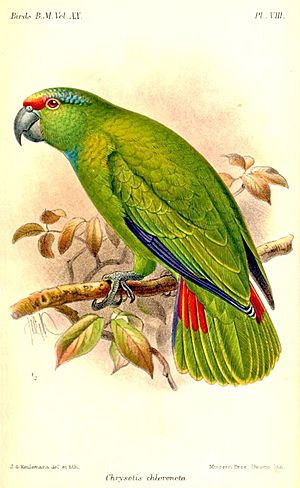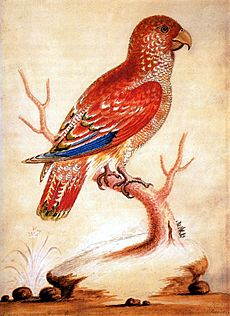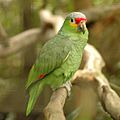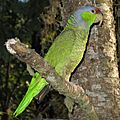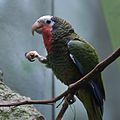Amazon parrot facts for kids
Quick facts for kids Amazon parrots |
|
|---|---|
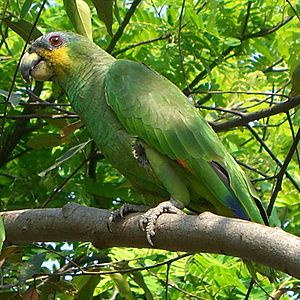 |
|
| Orange-winged amazon (Amazona amazonica) | |
| Scientific classification |
|
| Kingdom: | Animalia |
| Phylum: | Chordata |
| Class: | Aves |
| Order: | Psittaciformes |
| Family: | Psittacidae |
| Tribe: | Androglossini |
| Genus: | Amazona Lesson, 1830 |
| Diversity | |
| c. 30 species | |
Amazon parrots are a group of colorful birds. They are a type of parrot found in the New World. This means they live in places like South America, Mexico, and the Caribbean. They are known for their medium size and short tails.
Most Amazon parrots are mostly green. But they also have bright patches of other colors. These colors can be very vivid and depend on the specific type of parrot. They mainly eat seeds, nuts, and fruits. They also munch on leafy plants.
Many Amazon parrots are amazing at copying human speech. They can also mimic other sounds they hear. Because of this, they are very popular as pets. Some people even breed them to sell as pets. This popularity has caused a problem. Many parrots were taken from the wild. This has made some species endangered. To help protect them, there's a rule called CITES. This rule makes it illegal to catch wild parrots for the pet trade.
Contents
What are Amazon Parrots?
The group of birds called Amazona was first named in 1830. This was done by a French scientist named René Lesson. The name Amazona comes from the idea that these birds lived in the Amazon jungles. This idea was from the 1700s.
Different Kinds of Amazon Parrots
There are about 30 different kinds of Amazon parrots. Here are some of them:
- Festive amazon, Amazona festiva
- Vinaceous-breasted amazon, Amazona vinacea
- Tucumán amazon, Amazona tucumana
- Red-spectacled amazon, Amazona pretrei
- Black-billed amazon, Amazona agilis
- White-fronted amazon, Amazona albifrons
- Yellow-billed amazon, Amazona collaria
- Cuban amazon, Amazona leucocephala
- Hispaniolan amazon, Amazona ventralis
- Puerto Rican amazon, Amazona vittata
- Lilac-crowned amazon, Amazona finschi
- Red-lored amazon, Amazona autumnalis
- Lilacine amazon, Amazona autumnalis lilacina
- Diademed amazon, Amazona diadema
- Red-crowned amazon, Amazona viridigenalis
- Yucatan amazon, Amazona xantholora
- Blue-cheeked amazon, Amazona dufresniana
- Red-browed amazon, Amazona rhodocorytha
- Red-necked amazon, Amazona arausiaca
- St. Lucia amazon, Amazona versicolor
- Yellow-headed amazon, Amazona oratrix
- Tres Marías amazon, Amazona tresmariae
- Yellow-naped amazon, Amazona auropalliata
- Yellow-crowned amazon, Amazona ochrocephala
- Panama amazon, Amazona ochrocephala panamensis
- Yellow-shouldered amazon, Amazona barbadensis
- Turquoise-fronted amazon, Amazona aestiva
- Scaly-naped amazon, Amazona mercenarius
- Northern mealy amazon, Amazona guatemalae
- Southern mealy amazon, Amazona farinosa
- Kawall's amazon, Amazona kawalli
- Imperial amazon, Amazona imperialis
- Red-tailed amazon, Amazona brasiliensis
- Orange-winged amazon, Amazona amazonica
- St. Vincent amazon, Amazona guildingii
Scientists sometimes disagree on how to group the yellow-crowned amazon. Some think it's one species. Others split it into three different species. They look at how much yellow is on the bird and the color of its beak and legs. But studies of their DNA don't fully support these splits.
In 2017, some bird experts suggested a new species. They called it the blue-winged amazon. It was found in Mexico. However, later studies questioned if it was a truly new species. They thought it might be a mix of other parrots.
Parrots That Are No Longer Amazon Parrots
The yellow-faced parrot used to be considered an Amazon parrot. But new research shows it's actually more closely related to other types of parrots. So, it was moved to its own group.
Amazon Parrots That Might Be Extinct
Some Amazon parrots that lived on the Caribbean islands are now gone. These include parrots from Martinique and Guadeloupe. We don't know if they were unique species or just types of parrots brought to the islands by people. Because of this, they are called "hypothetically extinct species." We don't have any proof of them left.
- Martinique amazon, Amazona martinica (might be extinct).
- Guadeloupe amazon, Amazona violacea (might be extinct).
Amazon Parrots as Pets
Many Amazon parrots are kept as pets. Some popular ones include the yellow-headed amazon and the orange-winged amazon. Amazon parrots are known for being very good at talking. They are also playful and can use their feet well.
A well-trained parrot can be a very loyal friend. They can live for 50 years or even longer when cared for by humans. But some Amazon parrots can become aggressive. This might happen during mating season.
Pet parrots need a lot of training. They need more than dogs or cats. They need to be understood. They also need toys they can chew on safely. If they don't get enough attention and training, they can become aggressive. They love to chew, so they need toys that are safe to destroy.
Amazon parrots also eat a lot. They can get too heavy if they don't get enough exercise.
Gallery
- Extant species
-
Yellow-headed amazon
(Amazona oratrix) -
Cuban amazon
(Amazona leucocephala) -
Red-lored amazon
(Amazona autumnalis) -
Saint Vincent amazon
(Amazona guildingii) -
White-fronted amazon male
(Amazona albifrons) -
Red-crowned amazon
(Amazona viridigenalis) -
Lilac-crowned amazon
(Amazona finschi) -
Puerto Rican amazon
(Amazona vittata)
- Hypothetical extinct species
-
Martinique amazon
(Amazona martinica) -
Guadeloupe amazon
(Amazona violacea)
Images for kids
-
A. pretrei in a cage.
-
A. autumnalis salvini (red-lored parrot) feeding
-
A. leucocephala (Cuban amazon) feeding using its foot
-
Two captive A. auropalliata (Yellow-naped amazons) feeding
-
Two A. autumnalis salvini (red-lored parrots) flying together
See also
 In Spanish: Loros amazónicos para niños
In Spanish: Loros amazónicos para niños


